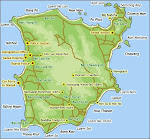
Aedes aegypti mosquito obtains a "blood meal." The A. aegypti mosquito is the primary vector for dengue and yellow fevers. (Credit: Image courtesy of Cornell University)
After malaria, Dengue (pronounced deng-GAY) fever is the most common disease transmitted to and between humans by mosquitos, and the most significant emerging disease among international travelers, with a 30-fold increase in incidence over the past 50 years worldwide.
Dengue includes four distinct viruses or serotypes. All are mostly transmitted via the bite of Aedes mosquitoes which become infected with dengue after taking a blood meal from a dengue-infected person. Most cases are mild. Symptoms include fever, rash, headache, and intense pain behind the eyes, muscles and joints. There is no cure for dengue infection, but management of the disease's effects can prevent the worst outcomes.
According to the WHO, dengue hemorrhagic fever (DHF), the most serious of the serotypes, is characterised by fever, low platelet count, clinical evidence of leaking capillaries, and spontaneous bleeding or fragile blood vessels. The most serious cases can lead to dengue shock – a drop in blood pressure and failure of blood cells to meet the metabolic demands of the body. DHF is a leading cause of death among children in Southeast Asia. In recent years hemorrhagic dengue, which is common throughout the sub-continent and Southeast Asia, has become increasingly prevalent in Africa and tropical America.
It's possible to become infected with dengue fever multiple times, but an attack of dengue produces immunity for a lifetime to that serotype to which the patient was exposed.
So why am I telling you all this? Because Lucy contracted DHF and I flew to Samui to be with her last week. Fortunately, she checked into the island's Bandon Hospital and started receiving treatment promptly to reduce the fever and relieve some of her discomfort. Lucy's blood was checked several times daily and only when her platelet and white cell count started, finally, to rise, at which time the DHF antibodies were detected, would the doctor agree to discharge her.
Occasionally hard to spot in her hospital issue matching pajamas and bed linen, I like to think that Lucy's recovery was hastened by the visits and gifts of 'Chicken Essence' from friends and Baan Bophut's Thai hotel staff. Here, Lucy is pictured clinging to her stock (unintended pun - ignore) of the restorative, often given by Thai's in much the same manner that westerners would take grapes to a friend in hospital.
Dengue II - the unintended sequel...
Even as I was writing the last post my own blood pressure and platelet count was falling as I too succumbed to dengue fever, having shared a mosquito too many with Lucy before she was clear of her own infection, either as we sat together in the hospital garden on the day before she was discharged, or in the car the day I took her home.Having spent the previous week with Lucy, I had a pretty good idea what I was in for when I checked into Dubai's American Hospital last Tuesday night, but nothing had prepared me for the magnitude of discomfort wrought by the symptoms in combination.
Anyway, it's taken six days of saline drip and numerous painkillers and TLC by the hospital staff to bring me to the point, today, when my platelet count showed an increase at last and dengue antibodies were confirmed as being present, enabling me to be discharged.
My infection was as a result of my own stupidity in not taking any of the precautions to limit my attraction to mosquitos. A DEET based repellent would have saved me an awful lot of pain and a week's misery. A Dengue epidemic has been declared in Rayong province and Bangkok is seeing unprecedented levels of infection. However, the chances of a visitor catching dengue during a two week holiday are estimated at over 10,000:1 and much less if basic mosquito bite avoidance is applied.















No comments:
Post a Comment